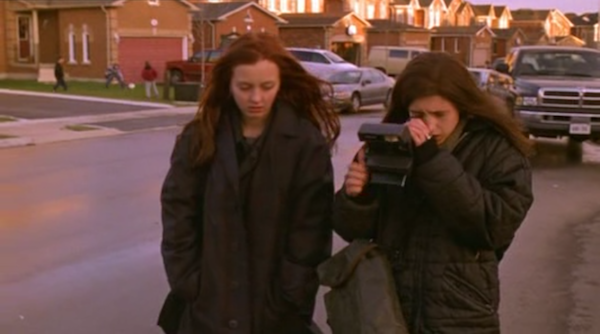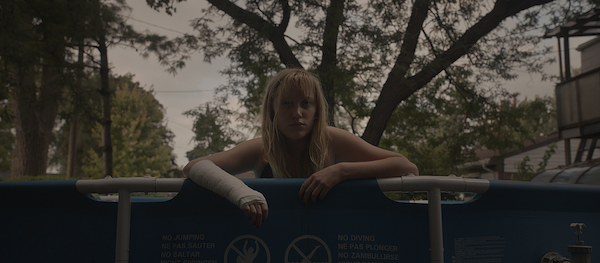It Follows, this year’s genre film of choice for mainstream critics, has been compared to many films. With its indeterminately-retro vibe, well-executed tracking shots, and melodic yet creepy score, it hearkens back to tons of movies, and it’s clearly a descendant of the genre as a whole and its various obsessions; youth, death, sex, dread, and transformation are all invoked, particularly the relationship between sex and death. Essentially, whatever films you grew up with or that strongly affected you were the films you’d see staring back at you from the screen. Today’s widely-read critics mostly grew up in the age of the slasher, so they see the late 70’s and early 80’s in it. So maybe that’s the reason the film’s most obvious parallel- to me, at least- was something I really never saw mentioned in any of the countless thinkpieces and rave reviews of It Follows that heralded its arrival as the horror film smart people were allowed to like this year. The horror films I saw as I came of age were from the late 90’s and early 2000’s, so my vantage point saw something different. When I saw It Follows, I saw Ginger Snaps.
The 2000 Canadian teen-horror film shares very little with It Follows stylistically. Outside of their non-traditional pacing and lopsided structures, they appear totally different on a surface level. Where It Follows is slow and deliberate, almost mumblecore in its approach to dialogue and interactions, Ginger Snaps is quick, witty, and artificial in a way common to horror films of its era (which I don’t say negatively; artificiality is rarely as bad as the connotations of the word imply). Ginger Snaps has its share of wonderful practical creature effects and a nice helping of blood and guts, where It Follows requires little more than some invisible hands moving appliances around to visualize its monster. Thematically, however, they parallel each other wonderfully, expressing the horror of sex, violence, and being a teenager on the cusp of adulthood, unable to get a grasp on how you’re going to move between the two. Essentially, both films are about how sexual maturation changes your world from one where death is an abstract possibility into one where it’s crushingly real.
Ginger Snaps tells the story of two sisters in high school, both obsessed with death, who are friends with no one besides each other. When the older sister Ginger (played by Katharine Isabelle) is attacked by a giant wolf-like creature one night (not coincidentally, the night she gets her first period), she begins to change, growing hair where her wounds were, craving blood, and developing a whole new personality. Her sister Brigitte (Emily Perkins) is both concerned for her sister and lonely as Ginger’s new demeanor has left Brigitte behind, and she seeks helps from local drug dealer Sam to change Ginger back and cure her. Physically and emotionally, the change is a metaphor for puberty, for the transition between childhood and adulthood and, in that, the understanding of death broadens and becomes something different. Death moves from an abstract- the pictures the girls take for a class project of themselves covered in corn syrup blood, splayed across various macabre tableaus- to the real, as Ginger’s transformation becomes more and more dangerous to herself and the people around her.
In a similar vein, It Follows tracks Jay (Maika Monroe) as she deals with a strange kind of affliction. After having sex for the first time, she is told she’s been infected with something, a supernatural disease. For the rest of her life, there will be something following her, something only she can see, and if it catches her it will kill her, graphically and horribly. The only way for her to survive is to pass it on by having sex with someone else, although she will for the rest of her life be able to see the figure following anyone who is infected, and if the person who she passed it on to dies, she will be in danger again as the curse reverts back to her. The early word on It Follows used the shorthand of “supernatural STD”, but in reality the most interesting aspect of its premise is this idea of sex as a passage into adulthood, and as such a gaining of knowledge, specifically again the knowledge of death. The younger kids around her can be touched by death, can be hurt by it, but they can’t see it. They can’t understand it, and it isn’t tracking them. Death becomes something more than an idea when you become an adult; it becomes a reality.
In both films, sex becomes the transference of knowledge, and as such the transference of pain and suffering. In It Follows, this is the premise of the film, but it’s also touched on incidentally in Ginger Snaps. When Ginger has sex with a horny schoolmate, he begins to transform as well, in much less charming ways than Ginger; his skin blisters, he pees blood, and his sexual aggression amplifies into physical violence, where threats become action. The people who pass on the knowledge of adulthood- be they werewolf or teen boy- can’t do much to help the people who are facing this dread head on. In It Follows, the boy who infects Jay explains the entire mythology of the being that will be chasing her, but that doesn’t really help. All the information in the world can’t really help, because this experience is so personal; the knowledge becomes a disease, and each body fights disease differently. Some will inevitably fail.
The reason these themes resonates so strongly in genre film is because rather that talking about this transition to adulthood and its attendant horrors bluntly (as in the interminable and ridiculous Kids), they work as metaphor and abstraction that can externalize the threat of growing up, turning it into a monster that can be grappled with. In both films, but especially Ginger Snaps, the line between sex and violence becomes complicated and mixed, and what was desired (in It Follows, sex, in Ginger Snaps, death) shows the ugliness and cruelty inherent within it. When Ginger throws up blood after eating the dog next door (and after having sex with the high school skeez), she tells her sister, “I get this ache, and I thought it was for sex, but it’s to tear everything to fucking pieces.” The two impulses are confused and mixed, especially in a sexist culture (it’s no coincidence that the protagonists in both films are young women) that often conflates the two. The idea of loving someone and the idea of that person being able to hurt you haven’t been separated or fully formed, so they swim around each other, circling their conflicts and meshing together into the hormonal rush of puberty.
This is about more than just sex, it’s about emotional maturity, about physical maturity, and about understanding the changing nature of what the world expects from you. Not everyone can relate to the sex in It Follows, but they can relate to the loneliness that comes with growing up before your friends, about feeling separated from the world you’d known your whole life, and the awkward attempts at trying to restore or maintain connections to your former life. They understand the confusion and pain Brigitte feels when her sister, her best and only friend in the whole world, throws her aside and seems to change overnight. The sex is just a means to an end; what is really being addressed is the disconnect between childhood and adulthood. The horror in Ginger Snaps isn’t Ginger, and the horror in It Follows isn’t the being. It’s what these things do to people, about the way that the bridge to adulthood contorts and disfigures all who cross it. The horror is change and loneliness.
What Ginger Snaps does so wonderfully, and what’s made it survive past a DOA theatrical release, is to express this confusion. On first viewing, the emotional state of the characters can seem strange or random at times, but on rewatch it shows itself as a document of teenagers, and teenagers aren’t known for their emotional consistency. Instead, Ginger and Brigitte are real, living people, full of love for each other but animosity as well, totally inseparable until suddenly one of them changes. It’s not even Ginger’s fault, how she treats Brigitte; her body is both literally and metaphorically changing, and her perspective is changing as well. She tries to do as well as she can, but the violence and sex explodes out of her, creating something grotesque and frightening that endangers everyone around her, including Brigitte. The knowledge and information infects the world she touches; adulthood corrupts the (imagined) purity of childhood. We all end up as the werewolf, one way or another.





